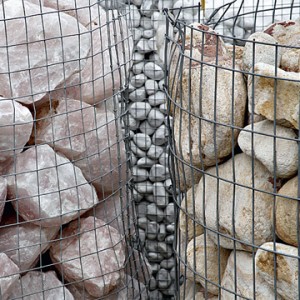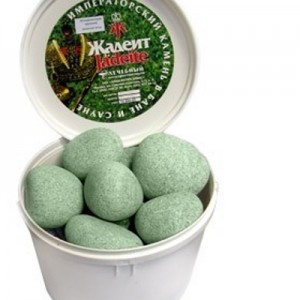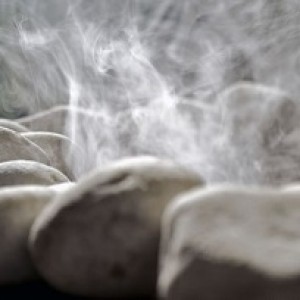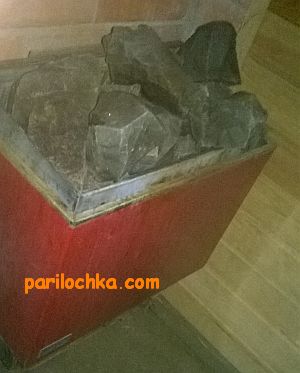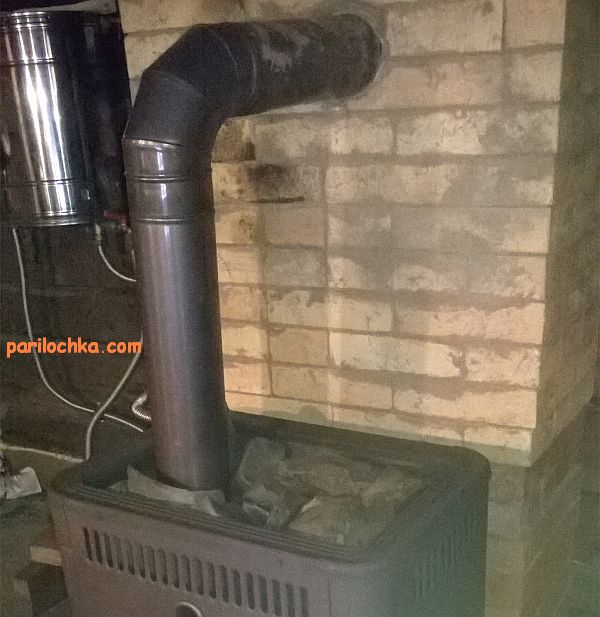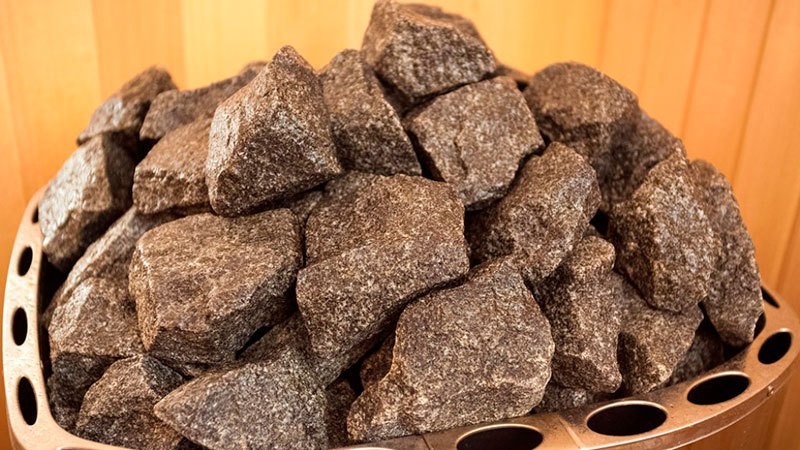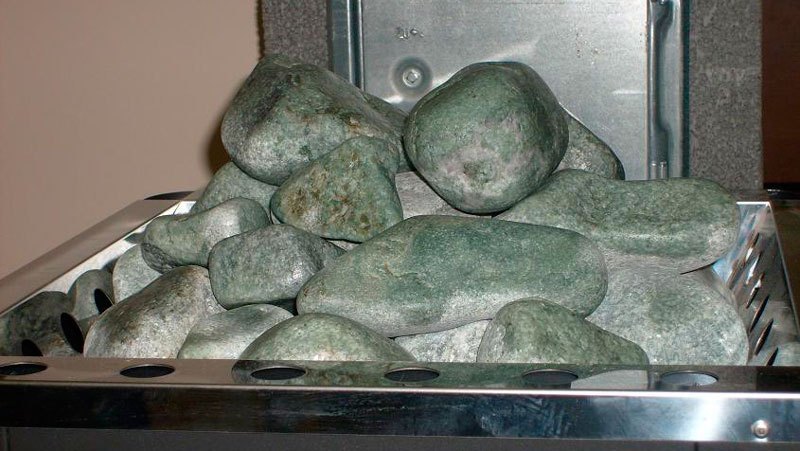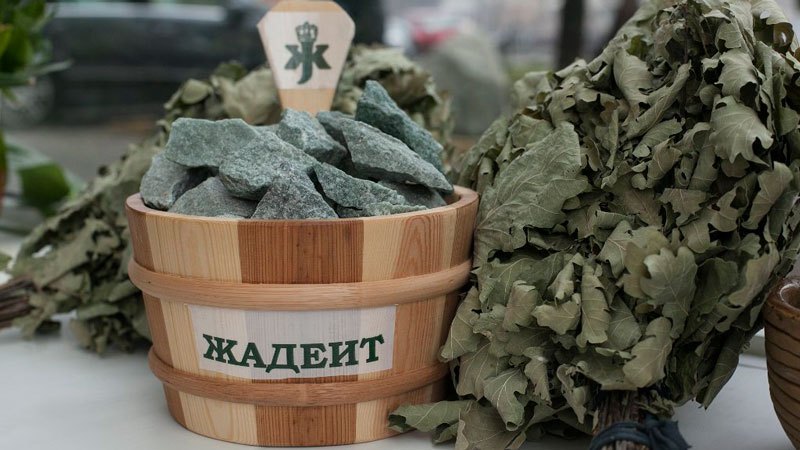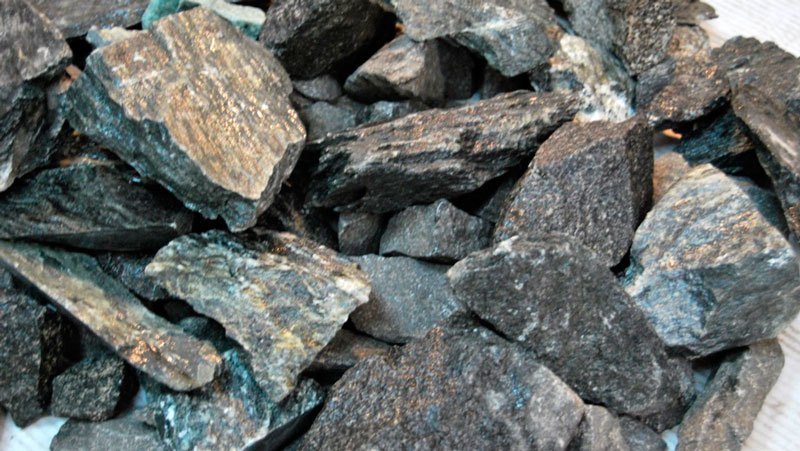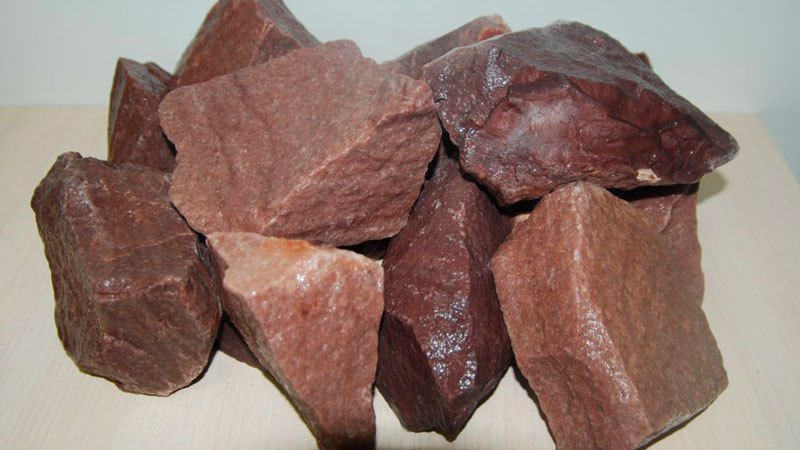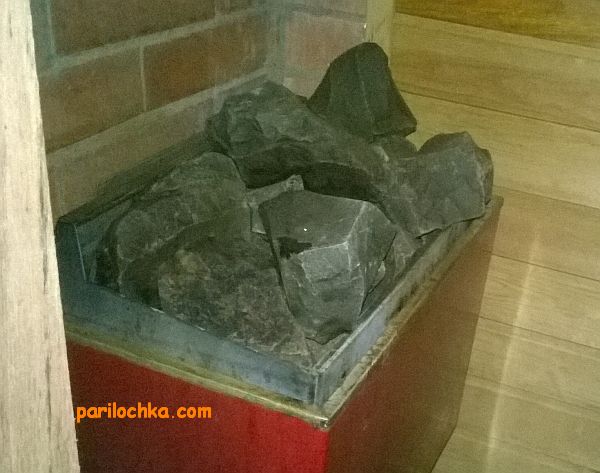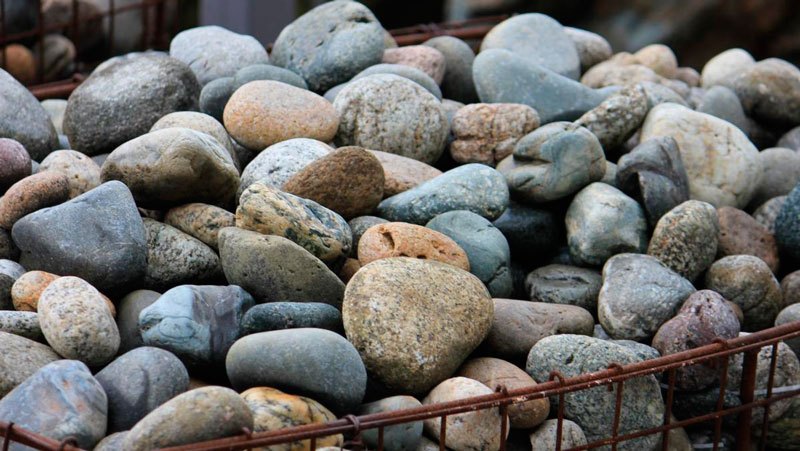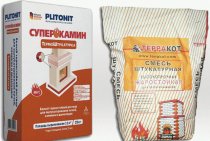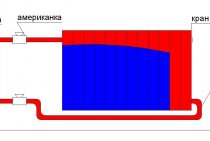Where to get
River stones for a steam room
We have already talked about this in an article on how to choose bath stones. However, we can do it again. There are two main sources: nature and the store. Those who have some experience in distinguishing unsuitable sedimentary rocks can "harvest" in a field, forest, or on the banks of a mountain river. Local residents can tell you where to find suitable stones in the sauna stove, at the same time they will show you how they look.
If you do not have such experience, and the locals themselves buy in the store, then it remains only to follow their example. In order to prevent dishonest sellers from deceiving you, read the article we have already mentioned or (if you have already figured out what to choose) an article about a specific breed - we usually give information on how to check quality and authenticity. Here are some rocks you can read about here:
- Quartz and crimson quartzite
- Jade
- porphyrite
- Soapstone
- Dunite
- Gabbro diabase
- Nephritis
In addition, there is an article about which stones for baths and saunas are better.
Learning how to choose and care for stones
Before you purchase minerals for the furnace, consider each one carefully. They should not have cracks, and the structure should be dense. To test for strength, you can take two elements and hit them against each other. They should not crumble, and the sound will be sonorous. A more effective way to hit with a hammer, but this is prohibited in stores.
You can check already purchased items by heating them to a high temperature and pouring them into a bowl of water. If no cracks appear, then the purchase can be used in the sauna stove, and the heat transfer from them will be uniform.
Do not forget that everything has its own service life, and the heater is exposed to heat all the time. Its contents quickly become unusable. The heat output from the heater drops by 20-30% in a year. It is necessary to get all the material once a year, inspect and replace the damaged one. Whole ones are washed under running water. If possible, it is better to change the contents of the heater once a year.
Form matters
For less cracking, it is better to take smooth rounded stones. In addition to strength, they will give off heat better and air circulation in the steam rooms will be faster. Uneven with potholes when heated, they will quickly begin to collapse and crack.
When choosing stones, the size of the heater matters. If a small iron stove is used, it is better to use a smaller fraction. Massive and heavy specimens are suitable for brick wood stoves.
How to place stones in the furnace
It is important not only to choose the size, but also to decompose them in the oven capacity. It all depends on where the stone is located.
Usually the stove heats the heater from below. In this case, the largest fraction is placed below, a layer of the middle one is laid on it, and the smallest ones are on top. So the grate between the container and the chamber where the fuel burns will close minimally and the stove will warm up faster.
Structure - which is better
Stones with a layered structure, a sandy layer cannot be used for a bath. It will quickly crumble and clog the holes for air circulation, there will be less steam, and the smoke will be worse to leave.
You can hear how the seller recommends using minerals of volcanic origin for the bath. This is a big mistake! They heat up really faster and keep heat for a long time, but when water is supplied, the fraction splits, throwing small particles into the steam room. They can be harmful to health, so using a volcanic stone for a bath is not safe! They can only be used with a protective grid.
Natural or artificial material?
Specialized departments offer the buyer both artificial and natural natural material.Natural is better, it is environmentally friendly and brings healing energy to the bath.
Artificial ones are cheaper and warm up faster, but they do not keep the temperature for long, and their energy is dead. There will be little benefit from such a pair.
It is better to buy stones in specialized stores, this is facilitated by a number of factors:
- Not everyone has access to different types of stone and is able to distinguish one from another.
- The optimal fraction for furnaces is selected for sale.
- The stones undergo special treatment before being sold, and foreign microorganisms and viruses will not get into the steam room.
The right stones for the sauna stove should not only have the right size, density and shape, but also the breed. Consider the rocks of minerals that have proven themselves in the steam room only from the best side.
Is it possible to mix bath stones
The answer to this question is definitely positive. You can mix. Moreover, you are free to lay them out in layers or interfere with different ones within the same layer.
Many of those who have an open fire in the furnace or do not have the opportunity to fill the entire volume with expensive rocks use cheaper ones for the lower layers. Or they do the same for other reasons, for example, as mentioned at the beginning, in order to accelerate heating due to different thermal conductivity and heat capacity of rocks. The third reason is purely aesthetic. You can choose colors so that they look beautiful when wet. For example, by mixing green and red specimens. Or red and grey.
How to prepare a stone
- soak the batch simply in water without anything for several hours (you can not do this, but this is also a test: watch out for gas bubbles - this is a sign of cracks, specimens with bubbles must be removed);
- then go over each thoroughly with a stiff brush and rinse under running water.
The washed batch can be ignited and thrown into water. If one of them breaks, it will be discarded.
In the future, the stones will need to be sorted out with a certain regularity. You can do this once a year, every six months, every season. Deterioration in the quality of heating may be a signal for an unscheduled revision.
Laying stones in the oven
How to put the stones in the sauna oven? Almost every buyer asks this question. Along the way, questions arise:
- What is the best way to heat a stone?
- What volume of stone backfill should be?
- How to prepare a stone?
- How to choose a stone?
- How long should a stone be used?
Let's get straight to the volume. The volume of stone laying in the furnace must meet the requirement to maintain the microclimate of the steam bath and the intensity of steaming. In the absence of a steam generator at the stove, the stone must provide high-quality soaring throughout the entire period, and then it turns out that there should be a lot of stone. But a lot is a relative concept, since a stone heated to 200 * C will give out several times less steam from the same amount of stone that is heated to 400 * C. And this concept suddenly begins to depend on the design of the furnace, the selection of its power and the skill of the attendant. Many passports give a standard calculation of stones for a sauna stove, which is tied to the area of \u200b\u200ba steam room equal to 30 - 50 kg of stone per 1 square meter. However, this is such a primitive selection that it is more suitable for a black sauna. If anyone does not know, then the black bath had a hearth with the laying of stones of at least 500 kg, which were heated by an open fire to the state of a crimson glow. The stone, of course, heated up for a very long time and it was an unsuccessful decision, but at that time it was practically the only one. A well heated stone to a crimson glow, of course, had an excellent ability to vaporize. For this reason (the quality of the steam), the black sauna was declared a classic sauna.
And since the stones in that period were the only source of steam. Then they put forward certain requirements:
- Stones must be resistant to high temperatures.
- The stones must have a good ability to store heat.
- The purity of stones from salts of heavy metals, radioactive elements and any organic and harmful impurities.
- In addition to the accumulation of heat, it is necessary that the stone also quickly gives it away.
- The bath stone is also valued for its mechanical strength to sudden cooling after strong heating.
- Since the stone is poured into the equipment, the requirement for the preservation of this equipment is a minimum thermal expansion.
- And, of course, the stone should please the eye - a beautiful shape and color matter.
Stones are washed in running water before laying. They sort it out - rejecting it: with cracks, streaks uncharacteristic for it, foreign smell. After that, the stone is laid in the heater, first the largest one. In between and on top, small, the stone is laid tightly to the surface of the stove and without voids in the heater - the quality of its heating depends on this. The stone cannot be placed on the heated surface with an edge, only with a plane - this will accelerate its heating. The stone for open and closed heaters is laid equally tightly without a difference. The only difference can be for stones heated by direct fire and hot gases - these stones are laid loosely without a small stone, so that hot air or flame can move freely between the stones. It must be remembered that it will take more time to heat the stone - firewood and time in a closed heater than in an open ventilated one. This is due to the fact that stones in a closed heater are heated by the contact method of heat transfer from the walls of the furnace - inside the stone - to the walls of the stone - to the next stone, etc. In a ventilated heater, in addition to the contact method, incandescent air is involved in heating (similar to how a stone is heated when placed in a closed heater of a firebox heated by hot gases)
Another very important requirement is how much stone to put on the heater. For example, in a closed heater you cannot put more than the box can hold, but an open heater gives flight for the various desires of some to increase the heater.
The logic of such actions is simple: we need steam - steam gives a stone - so you need more stone - and there will be a lot of steam. But no! The more stone we put on, the less steam we get. There is a couple that you can steam. The upper stone does not heat up, and takes on water, evaporating it gradually and worsening the microclimate of the bath. In such baths it is damp and there is nothing to breathe. In no case should the stone be laid higher than the edge of the heater. Nothing will be gained from this. Large bulks suit managers in promotional units. But this is fake and nothing more. Take the right stone, lay it right and get the right steam. Watch our videos. If you don't understand, ask on our forum. We will definitely answer. Experts to help you.
What kind of water to pour on the stones in the bath
The question, by the way, is not at all idle. Understanding when and how much to pour water comes with experience, but what it should be, you need to know from the very beginning. The water must be warm.
IMPORTANT! The hotter the water is, the smaller the temperature difference for the stones will be, which means that their wear will be less, and you won’t have to spend extra firewood. One big benefit! Collect hot water in advance and place it near the heater so that it does not cool down
Collect hot water in advance and place it near the heater so that it does not cool down.
You can also prepare water with various additives, depending on the goal. For example, if you need to treat a cold, then add up to 10 drops of menthol or a teaspoon of dry mustard (per three liters of water) to the water for giving. On the same volume, you can pour 50 ml of beer or kvass, or herbal infusion, a tablespoon of ground coffee, drip aromatic oils.
There are many recipes. The main thing is that all these additives simply do not burn out on overheated stones. Therefore, a special place is usually allocated for such sacrifice. Or, as an option, they simply put a container with pleasantly smelling contents next to the heater.
Gabbro for steam bath
How to properly place stones in a sauna stove
Choosing the right sauna stones is only half the battle. It is also necessary to properly prepare them, and then lay them in the heater.
After the stones have passed an external thorough examination for defects and cracks, it is recommended to pre-treat them in a weak saline solution for 1-2 hours.
Before laying the stones in the sauna stove, they must be washed and dried in a natural way.
Thereafter:
- large specimens are placed in the lower part of the heater;
- further - average;
- y - small, at least 5-6 mm in diameter.
It is permissible to use stones of the same size, in this case, it is preferable that the diameter be in the range from 7-8 to 15 cm.
If the stove is iron, small in size, then very large samples should not be used, it is enough to stop at medium sizes. For electrical products, small stones placed in fairly narrow gaps between the heaters will be a suitable option.
In some cases, recommendations to use large or medium-sized stones for large wood-burning stoves are rationally justified. In this case, proper heat transfer is ensured. With dense laying, if small stones are used, this process is somewhat difficult. But not everything is so clear.
Steam and heat will find loopholes to get out anyway, so this moment is not so relevant. Especially if you look at the process from the other side. In the absence of small stones in the heater, water can get on the metal. In this case, a rather unpleasant, “hard” vapor is obtained, sometimes even with a specific metallic taste.
The use of small stones, especially when combined with large ones, is also supported by an increase in the overall specific heat of the stove. If stones of medium or fine fraction are used, then the packing density increases, and this affects the quality of the steam due to the fact that the water rolls down more slowly, reaches the lower, hotter layer, and does not evaporate on the way to it.
The steam is softer and drier. It is, based on this principle, that one should be guided when it comes to the question of which sauna stones are best, as well as what size they should be. Even taking into account the fact that the production of steam in this case is not expected.
It is also important to properly carry out the hardening of masonry. To do this, it is necessary to gradually heat the stones to redness in the lower part, then sharply pour water over them, naturally, cold
After waiting for the stones to cool completely, conduct a visual inspection for the appearance of defects and, above all, cracks, if necessary, reject low-quality specimens and replace them with new ones. In the event that you have to shift more than 30% of the stones, then the hardening procedure should be repeated.
Of course, the correct placement of stones in the sauna stove provides the best heat transfer and steam formation, but it is important to monitor the quality and purity of the water used for the stones. There must be a hot and clean liquid, even if special aromatic additives are used.
This guarantees not only more steam production, but also preserves the stones.
Electric heater for a bath selection criteria
In the last century, baths were built in order to wash there. Now the bath is more of a place of relaxation and healing of the body. If you decide to equip your bathhouse in the house or build your own bathhouse on the site, then one of the first questions you will face is which stove to choose. The best solution is to buy an electric heater.
Why choose an electric heater?
If not electrical, but any other energy is chosen for heating, then a number of factors will appear that will need to be taken into account when designing. You will need a separate place for storing fuel, a chimney system, etc.The heating of the bath will take place with mandatory control and security by the person. An exception is the use of natural gas and a special automation system. But this method of heating is very expensive and is more suitable for commercial baths. In a word, the use of non-electric energy for heating a bath is associated with solving many problems. But why make life difficult for yourself? When using an electric heater, everything is much simpler. It is only necessary to have electricity and follow the rules of electrical safety.
We determine the required power of the electric heater
As a rule, the steam room in the baths is small in size. But a modest area does not guarantee good heating from a low-power electric heater. To select the optimal power, it is necessary to take into account the dimensions of the dressing room and possible heat losses.
The power of electric heaters starts from 2.5 kW. Such power is sufficient for a small steam room of 2-2.5 cubic meters. m. In this case, it is worth considering the need for steam circulation. That is, the steam room must have an outlet for hot air. In addition, in the winter season, heating the bath takes longer than in other seasons. That is, the purchase of an electric heater with a power of up to 4 kW will be justified only for a bath inside the house. For baths located on the site, heaters from 6 kW are required.
Installation method
Electric heaters can be installed on the floor or on the wall. When installing on a wall, it should be borne in mind that the mass of the heater with stones can reach up to 35 kg. Therefore, you need to choose a place for a strong mount on a load-bearing wall. When placed on the floor, it must be taken into account that the weight of the heater with filling can reach 100 kg. Therefore, the place for its installation must be reliable and durable.
The basic rules for the installation and placement of electric heaters are prescribed in the instructions. However, here are the most important things to remember:
- The space above the stove should be enough for the free circulation of hot air inside the steam room.
- Flammable materials near the heater are not safe.
- It is necessary to ensure the safety of people, so the heater must be located at the required distance from the shelves.
In order to avoid burns, some manufacturers produce heaters with a Fiber coating, which not only reduces the possibility of injury, but also increases the fire hazard. In the absence of such a coating, a wooden fence can be installed.
Are stones important?
Proper laying of stones is very important to ensure sufficient heat. Large stones are placed at the bottom, smaller ones at the top. It is not worth filling the heater too tightly, as this will make it difficult for air to circulate inside the heater. Optimum stone placement ensures heat dissipation even after the heater has been disconnected from the mains
In addition, when laying, it is important to be careful not to damage the heating elements and not disable the oven.
Where to buy stones? They can be purchased at a specialized store. But the cost of filling the furnace will not be very cheap. If it is possible to bring high-quality gravel, then this option will be no worse than buying stones.
Which electric heater to choose?
It all depends on what you want to get as a result. If you just need a steam room, then you can get by with the standard model without frills. For lovers of unusual solutions, a large number of different options are presented on the market. But when choosing a fashionable stove, it is worth remembering that the price for it will be very high, and the practicality in comparison with the usual model will be only 5 percent more.
There are many manufacturers of electric stoves. But the most reliable are the Finnish models. Established brands such as Helo, Sawo and Harvia can be found at any specialty outlet. We hope that our tips will help you choose a good oven.But with all the pleasantness of the steam room and the benefits, you should not abuse it. Remember that everything is good in moderation.
The unique properties of jade stone
This stone of a greenish tint is one of the most durable among those used for heaters, belongs to semi-precious rocks and, accordingly, its price is one of the highest. Due to the fact that he has:
- beautiful appearance;
- high heat capacity;
- low water absorption;
- unique healing properties
its use in the heater is fully justified. Moreover, in order to reduce costs, it is possible to purchase not a complete set, but only a few stones and lay them on top of the masonry.
The beneficial effect of jadeite stone, especially when heated, on the circulatory, endocrine, genitourinary nervous and other systems of the body has long been known.
It has a powerful healing effect and for pain in the joints. Bioenergetics consider it a unique stone for restoring the human energy field.
- beneficial infrared radiation;
- air ionization;
- water enrichment with metasilicic acid.
Its service life is at least 5 years, only after which it gradually begins to lose its effectiveness.
When purchasing jadeite for a steam room, or choosing which stones are better for a heater, one should take into account that a chipped specimen is a suitable option for a Russian bath, due to the increased surface area providing more steam. Polished stone is more effective in the sauna.
Soapstone: the king of saunas
A stone with shades of gray, with high strength, fast heating ability and large storage capacity. A source of light and pleasant steam. If it is used together with other stones, one should take into account such a feature as dustiness, which can be avoided by thorough washing and hardening of all samples before placing them in the heater.
The stone is a source of soft "radiant" heat, the radiation wave of which coincides with the length of the thermal wave emanating from the human body.
Its homeland is Finland and Karelia, which explains its popularity in saunas, despite the fact that the cost is quite high.
Crimson quartzite
Thinking about which stones are better for the stove in the bath, you should also pay attention to raspberry quartzite, a bright purple-brown color. It is one of the strong rocks, resistant to cracking - it is not afraid even of cold water, which can be safely poured onto the heater
It has high heat capacity, low water absorption.
How to build a bath from a bar with your own hands? – more useful information here.
Its medicinal properties are also known:
- has a beneficial effect on the circulatory system, normalizing blood pressure;
- eliminates pain in the joints;
- helps with migraines, problems associated with changing weather;
- normalizes the functioning of the organs of the reproductive system.
But, most importantly, porphyry, as raspberry quartzite is otherwise called, gives out very light steam for a long time even after the stove has stopped working. Therefore, in a bath with such a stone, you can enjoy soft beneficial warmth for a long time.
You will be interested in this article - How to sheathe a bath inside with a clapboard with your own hands?
Sources
- https://parilochka.com/pechi-dlya-bani/kamni/ukladka.html
- http://v-banyu.ru/kak-vybrat-kamni-dlya-kamenki-v-banyu.html
- https://parilochka.com/pechi-dlya-bani/kamni
- http://banyabest.ru/pechi-dlya-bani/kak-vybrat-kamni-dlya-bani.html
- https://DimDom.ru/kamni-dlya-bani-kakie-luchshe-vybrat.html
Stones for electric heater
Gabbro-diabase for a steam room in an electric heater
An electric oven can be used with equal success in both Russian and Finnish baths
But here it is necessary to take into account such a nuance:
IMPORTANT! The smaller the volume of the electric heater, the more such a model is intended for a sauna. Models capable of operating in the “Russian bath” mode start with 60 kilograms of filler
Models capable of operating in the “Russian bath” mode start with 60 kilograms of filler
IMPORTANT! The smaller the volume of the electric heater, the more such a model is intended for a sauna. Models capable of operating in the “Russian bath” mode start with 60 kilograms of filler
The electric heater is sensitive not so much to the types of stones as to their size. If you can put samples of 13 cm in size in the usual one, then no more than 7 cm are suitable for this one. As for their installation, we have a separate detailed article on this topic.
Bath stone care tips
In order for the stones to serve for a long time, you need to know how to properly care for them.
- Before using the stones, it is necessary to check whether they are cracked, chipped or otherwise damaged. Then the stones are kept in salt water for an hour, washed thoroughly, preferably with a brush, but without the use of chemicals, and allowed to dry at room temperature.
- Experts advise filling the stove-heater in three layers with stones of different sizes, while leaving gaps through which steam and air will pass. Moreover, it is necessary to lay the largest stones from below (120-150 mm in diameter), and towards the top of the masonry, their size should gradually decrease.
- In order for the heater to warm up the steam room well, you should adhere to a ratio of 1:50 in relation to the volume of stones to the total volume of the room. The most optimal size is 70-150 mm in diameter.
- To ensure a long service life, the stones must be hardened. To do this, they are heated until red appears in the lower rows, and then abruptly doused with cold water. Stones on which cracks appear after such a procedure are rejected.
- You should constantly monitor the condition of the stones in the bath. In the event of the formation of plaque or contamination of the stones, they must be washed well and dried in the fresh air. Every three to four months, a complete inspection of all stones is carried out for the presence of chips, cracks and other defects, after which the damaged specimens must be replaced with new ones.
- It is necessary to water the stones during bathing procedures with strictly hot water, which significantly increases their service life and gives saturated hot steam.
What should be the stones in the heaters
Minerals for the heater are taken not only by those they like. Even recommended breeds must meet a number of characteristics:
- Eco-friendly and safe for health.
- By mass, the stones should be heavy, the fraction is medium, too small are not suitable, as well as too large. The density is high. This will prevent the minerals from cracking when interacting with water.
- The coefficient of thermal expansion should be the same, in other words, you need to take stones of the same breed and approximately the same size: large 7-13 cm, small - 4-6 cm. So the heater will warm up evenly.
- Tolerate high temperatures well.
- The surface is uniform.
- Classic rocks and ultrabasic ones should not contain more than 43-54% silica.
These characteristics are not always characteristic of a particular breed. It is better if most of them fit the chosen product.
How to choose stones for a bath or sauna
Choosing stones for a bath is a simple and at the same time difficult matter. Consideration should be given to such physical parameters of the material as:
-
density, that is, the greater the weight of the stone, the better;
-
heat resistance, the ability of a stone to experience a repeated process of heating / cooling without much loss (at least for a sufficiently long time) of its qualities and properties;
-
heat capacity, the property of a stone to accumulate and retain heat, with the aim of subsequent return to the environment. The higher the heat capacity of the material, the longer it retains the ability to maintain the required temperature after the furnace heating process stops.
There is a similar article on this topic - Stoves for a long-burning wood-burning home.
Must be:
-
environmentally friendly;
-
homogeneous in their structure.It is not recommended to use stones for a sauna stove with inclusions: because of this, uneven heating will occur, which will lead to their delamination and destruction;
-
without cracks: to check this quality, you should knock stones against each other or hit them with a hammer. A clear sound will indicate the absence of a defect;
-
approximately the same in size and shape - this will ensure uniform heating, air and steam circulation. Before you find out which stones in the steam room are best used based on their structure, preference should be given to specimens with a smooth surface, and based on the shape - oval or rounded.
Although some believe that studded stones have a larger area for reflecting heat and are more efficient. This is true, as well as the fact that smooth stones are less prone to cracking, which means they will last longer.
In addition, using a hammer, you can get information about the density of the sample. The following experiment will help you learn about the ability to withstand sudden temperature changes: after heating a stone to the highest possible temperature, it should be abruptly lowered into a bucket of cold water. The absence of cracks is a guarantee that a particular instance will last a long time.
Stones in a closed heater in a bath which are better
Jade for a sauna stove in a package (bucket)
A closed heater is a metal chamber inside the furnace, with a door and tubes, which, although not in direct contact with an open flame, is still in a zone of very strong heating, washed from the outside by fire and hot furnace gases. This significantly affects the duration of the "life" of cobblestones in a closed heater. They are faster and more susceptible to destruction than their counterparts in an open heater.
It is logical that in such a situation, the best will be those that are most tolerant of heat, that is, durable and refractory. Real jade will live here the longest - it has a fibrous and tangled structure, like felt, so it does not crumble.
But it should be understood that the stones will have to be changed often, so there are two ways out - either put cheap (or completely free) ones that are not expensive to change, or immediately invest in expensive things - in the same jade or stainless steel. As for jadeite, in this article we just mentioned a review about his stay in a closed heater - it was not without destruction.

